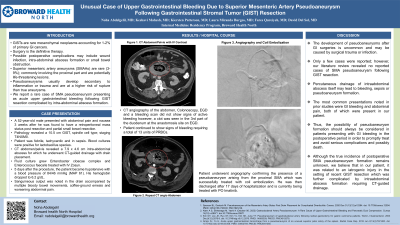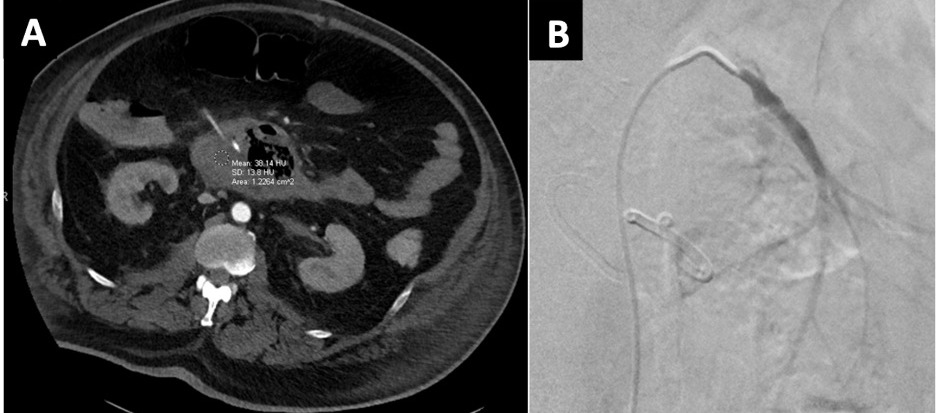Monday Poster Session
Category: GI Bleeding
P2096 - Unusual Case of Upper Gastrointestinal Bleeding Due to Superior Mesenteric Artery Pseudoaneurysm Following Gastrointestinal Stromal Tumor Resection
Monday, October 23, 2023
10:30 AM - 4:15 PM PT
Location: Exhibit Hall

Has Audio
- NA
Noha Abdelgelil, MD
Broward Health North Hospital
Deerfield Beach, FL
Presenting Author(s)
Noha Abdelgelil, MD, Keshavi Mahesh, MD, Kiersten Patterson, MD, Laura Miranda, MD, Fares Qureiyeh, MD, David Del Sol, MD
Broward Health North Hospital, Deerfield Beach, FL
Introduction: GISTs are rare mesenchymal neoplasms (1-2% of primary GI cancers) most commonly involving the stomach (40-60%). Surgery is the definitive therapy with postoperative complications including intraabdominal abscess formation or GI bleeding. SMA aneurysms are rare (3-9%) and are potentially life-threatening lesions. Pseudoaneurysms develop secondary to inflammation or trauma and are at a higher risk of rupture than true aneurysms. We report a rare case of SMA pseudoaneurysm presenting as acute upper gastrointestinal bleeding following GIST resection complicated by intra-abdominal abscess formation.
Case Description/Methods: A 52-year-old male with a 10.5 cm retroperitoneal mass resected one month ago (GIST spindle cell type T4NXM0) presented with abdominal pain. A 7.9x4.6cm intraabdominal abscess was noted on imaging which was treated with CT-guided drainage and drain placement. 5 days later, the patient became hypotensive and his hemoglobin level dropped to 6.2 g/dL. Sanguineous output was noted in the drain accompanied by multiple bloody bowel movements. To identify the source of bleeding, extensive workup was performed and did not show signs of active bleeding however, a clot was seen in the 3rd part of the duodenum at the anastomosis site on Esophagogastroduodenoscopy. Patient required a total of 13 units of packed red blood cells. A repeat CT angiography revealed bleeding within the mid-abdominal abscess cavity and possible SMA pseudoaneurysm. Angiography confirmed the presence of a pseudoaneurysm arising from the proximal SMA which was successfully treated with coil embolization. The patient was then discharged in a stable condition and is currently being treated with Imatinib.
Discussion: The development of pseudoaneurysms after GI surgeries is uncommon. Only a few cases were reported however, our literature review revealed no reported cases of SMA pseudoaneurysm following GIST resection. Drainage of intraabdominal abscess itself may lead to pseudoaneurysm formation. Thus, the possibility of pseudoaneurysm formation should be considered in patients presenting with GI bleeding in the postoperative period in order to promptly treat and avoid serious complications and possibly death. Although the true incidence of postoperative SMA pseudoaneurysm formation remains unknown, we believe that in our patient, it was probably related to an iatrogenic injury in the setting of recent GIST resection which was further complicated by intraabdominal abscess formation requiring CT-guided drainage.

Disclosures:
Noha Abdelgelil, MD, Keshavi Mahesh, MD, Kiersten Patterson, MD, Laura Miranda, MD, Fares Qureiyeh, MD, David Del Sol, MD. P2096 - Unusual Case of Upper Gastrointestinal Bleeding Due to Superior Mesenteric Artery Pseudoaneurysm Following Gastrointestinal Stromal Tumor Resection, ACG 2023 Annual Scientific Meeting Abstracts. Vancouver, BC, Canada: American College of Gastroenterology.
Broward Health North Hospital, Deerfield Beach, FL
Introduction: GISTs are rare mesenchymal neoplasms (1-2% of primary GI cancers) most commonly involving the stomach (40-60%). Surgery is the definitive therapy with postoperative complications including intraabdominal abscess formation or GI bleeding. SMA aneurysms are rare (3-9%) and are potentially life-threatening lesions. Pseudoaneurysms develop secondary to inflammation or trauma and are at a higher risk of rupture than true aneurysms. We report a rare case of SMA pseudoaneurysm presenting as acute upper gastrointestinal bleeding following GIST resection complicated by intra-abdominal abscess formation.
Case Description/Methods: A 52-year-old male with a 10.5 cm retroperitoneal mass resected one month ago (GIST spindle cell type T4NXM0) presented with abdominal pain. A 7.9x4.6cm intraabdominal abscess was noted on imaging which was treated with CT-guided drainage and drain placement. 5 days later, the patient became hypotensive and his hemoglobin level dropped to 6.2 g/dL. Sanguineous output was noted in the drain accompanied by multiple bloody bowel movements. To identify the source of bleeding, extensive workup was performed and did not show signs of active bleeding however, a clot was seen in the 3rd part of the duodenum at the anastomosis site on Esophagogastroduodenoscopy. Patient required a total of 13 units of packed red blood cells. A repeat CT angiography revealed bleeding within the mid-abdominal abscess cavity and possible SMA pseudoaneurysm. Angiography confirmed the presence of a pseudoaneurysm arising from the proximal SMA which was successfully treated with coil embolization. The patient was then discharged in a stable condition and is currently being treated with Imatinib.
Discussion: The development of pseudoaneurysms after GI surgeries is uncommon. Only a few cases were reported however, our literature review revealed no reported cases of SMA pseudoaneurysm following GIST resection. Drainage of intraabdominal abscess itself may lead to pseudoaneurysm formation. Thus, the possibility of pseudoaneurysm formation should be considered in patients presenting with GI bleeding in the postoperative period in order to promptly treat and avoid serious complications and possibly death. Although the true incidence of postoperative SMA pseudoaneurysm formation remains unknown, we believe that in our patient, it was probably related to an iatrogenic injury in the setting of recent GIST resection which was further complicated by intraabdominal abscess formation requiring CT-guided drainage.

Figure: Image A showing bleeding within the abscess cavity and a possible Superior Mesenteric Artery (SMA) pseudoaneurysm.
Image B Angiography shows a pseudoaneurysm involving the proximal part of the SMA.
Image B Angiography shows a pseudoaneurysm involving the proximal part of the SMA.
Disclosures:
Noha Abdelgelil indicated no relevant financial relationships.
Keshavi Mahesh indicated no relevant financial relationships.
Kiersten Patterson indicated no relevant financial relationships.
Laura Miranda indicated no relevant financial relationships.
Fares Qureiyeh indicated no relevant financial relationships.
David Del Sol indicated no relevant financial relationships.
Noha Abdelgelil, MD, Keshavi Mahesh, MD, Kiersten Patterson, MD, Laura Miranda, MD, Fares Qureiyeh, MD, David Del Sol, MD. P2096 - Unusual Case of Upper Gastrointestinal Bleeding Due to Superior Mesenteric Artery Pseudoaneurysm Following Gastrointestinal Stromal Tumor Resection, ACG 2023 Annual Scientific Meeting Abstracts. Vancouver, BC, Canada: American College of Gastroenterology.
